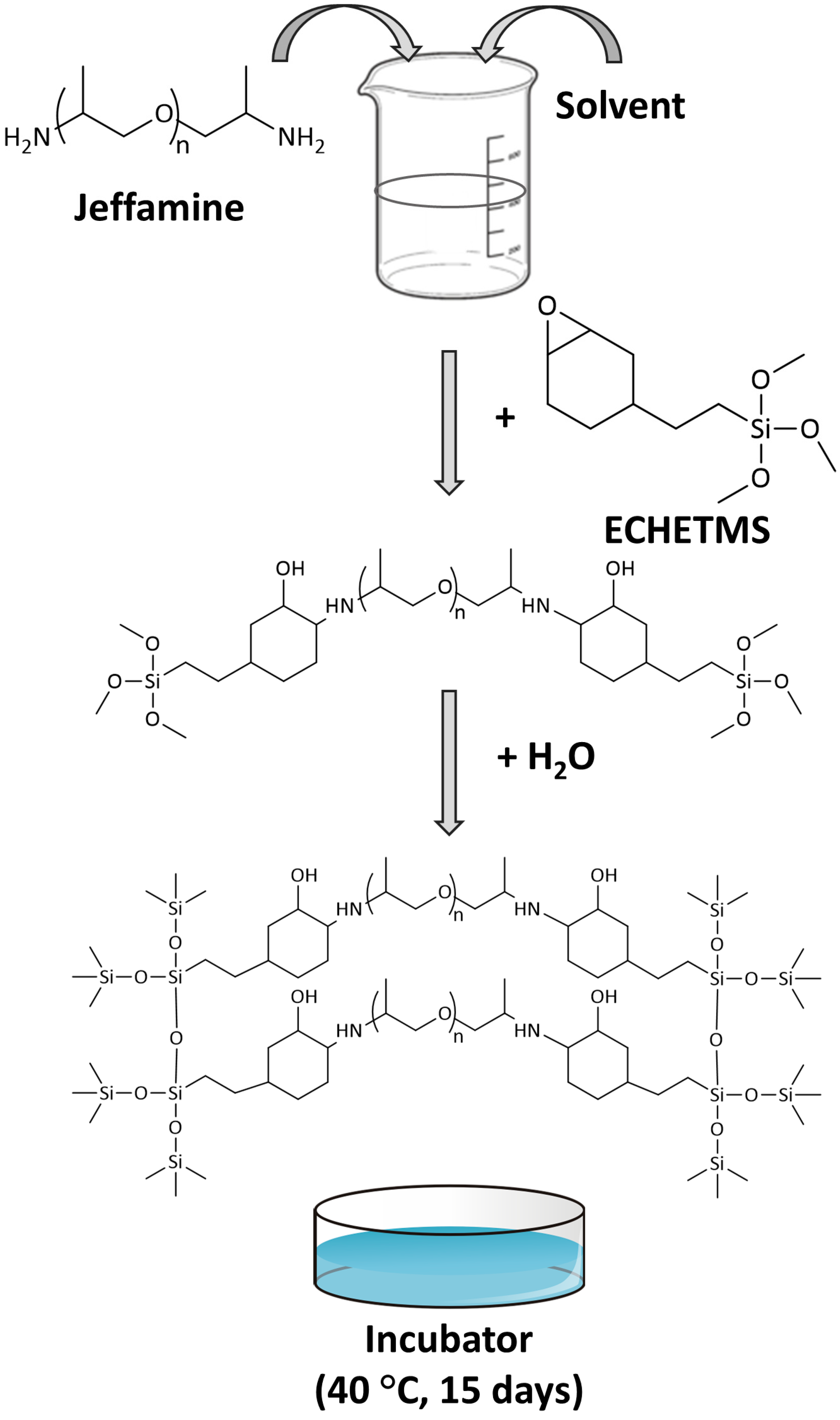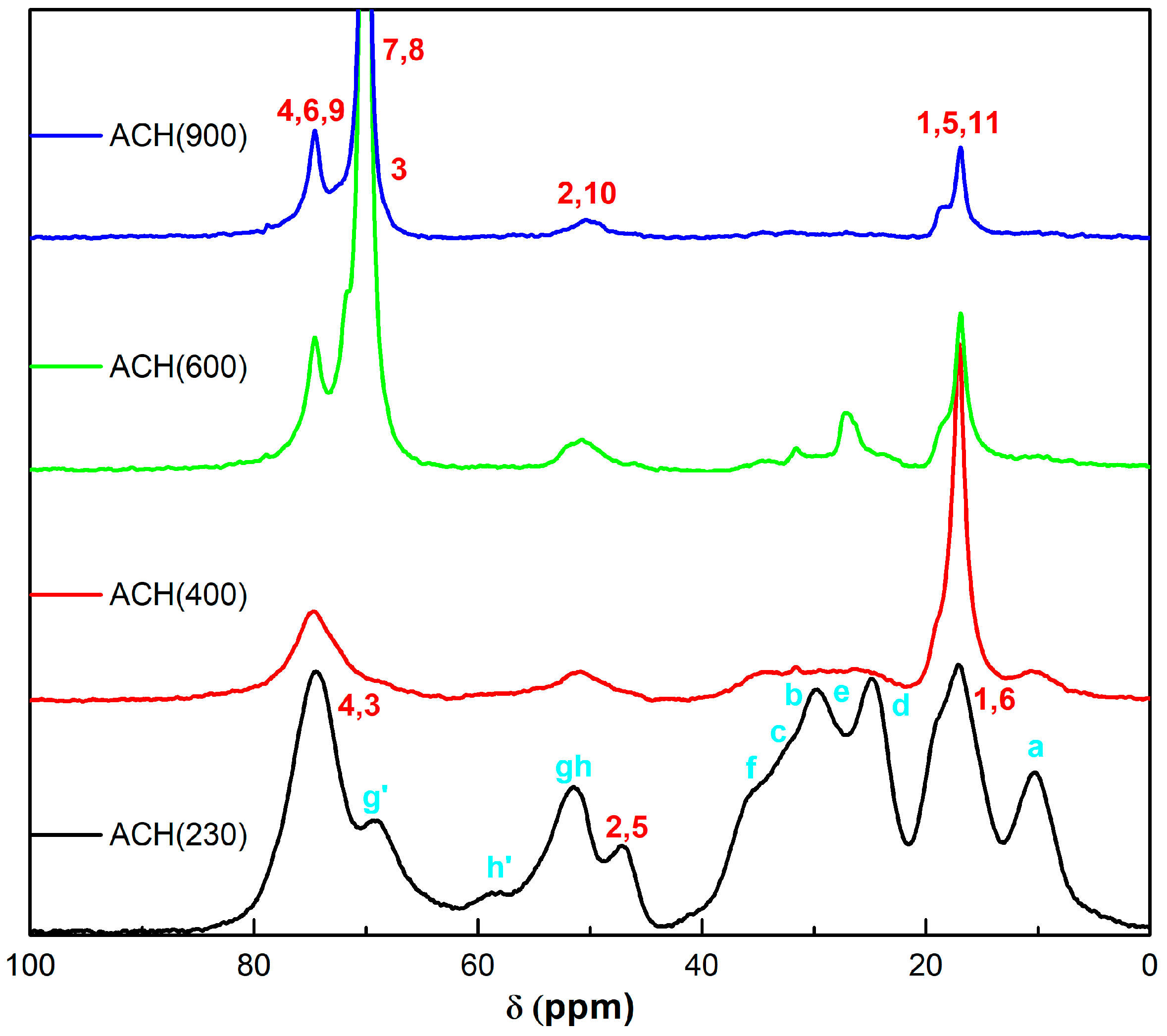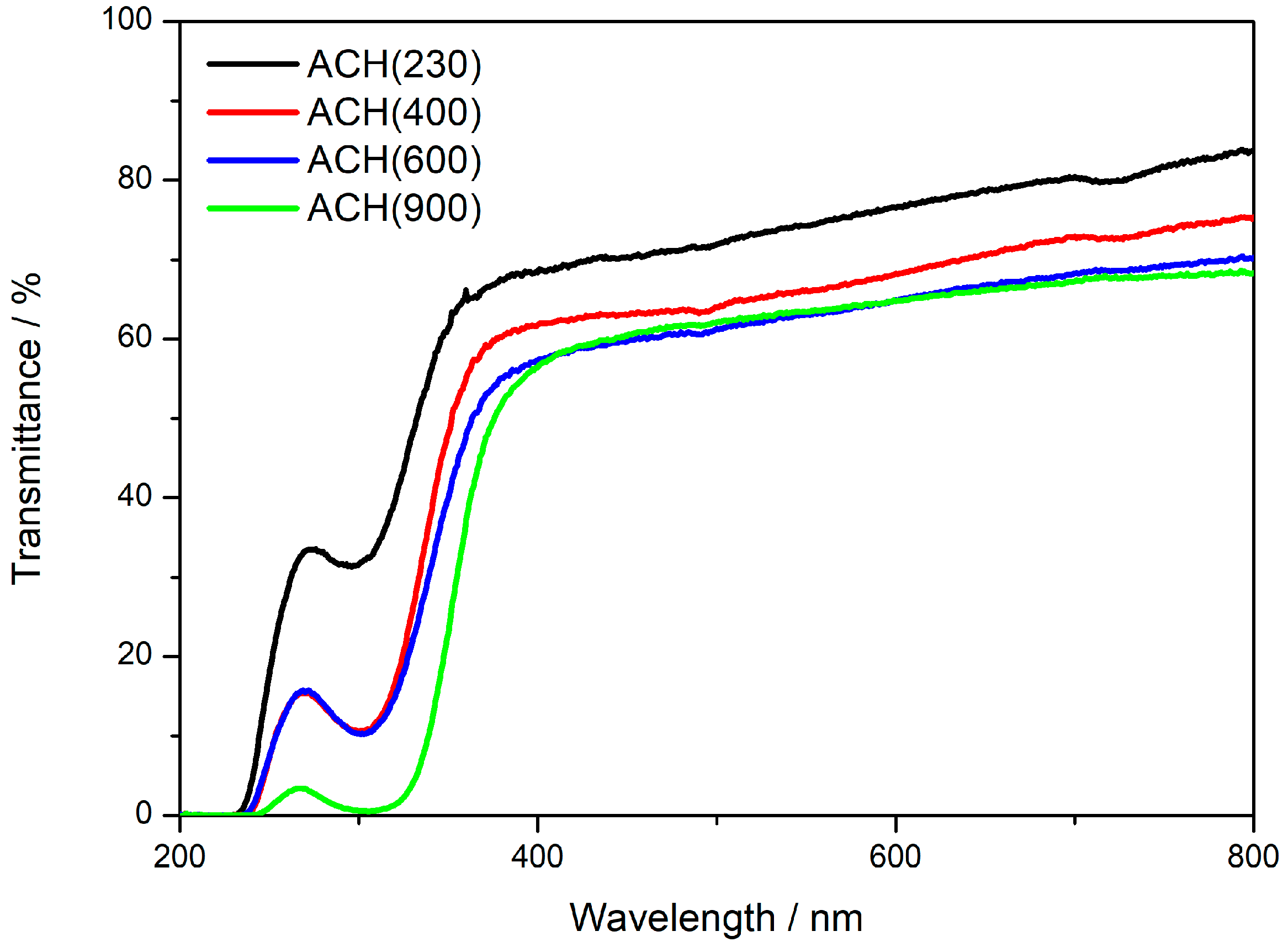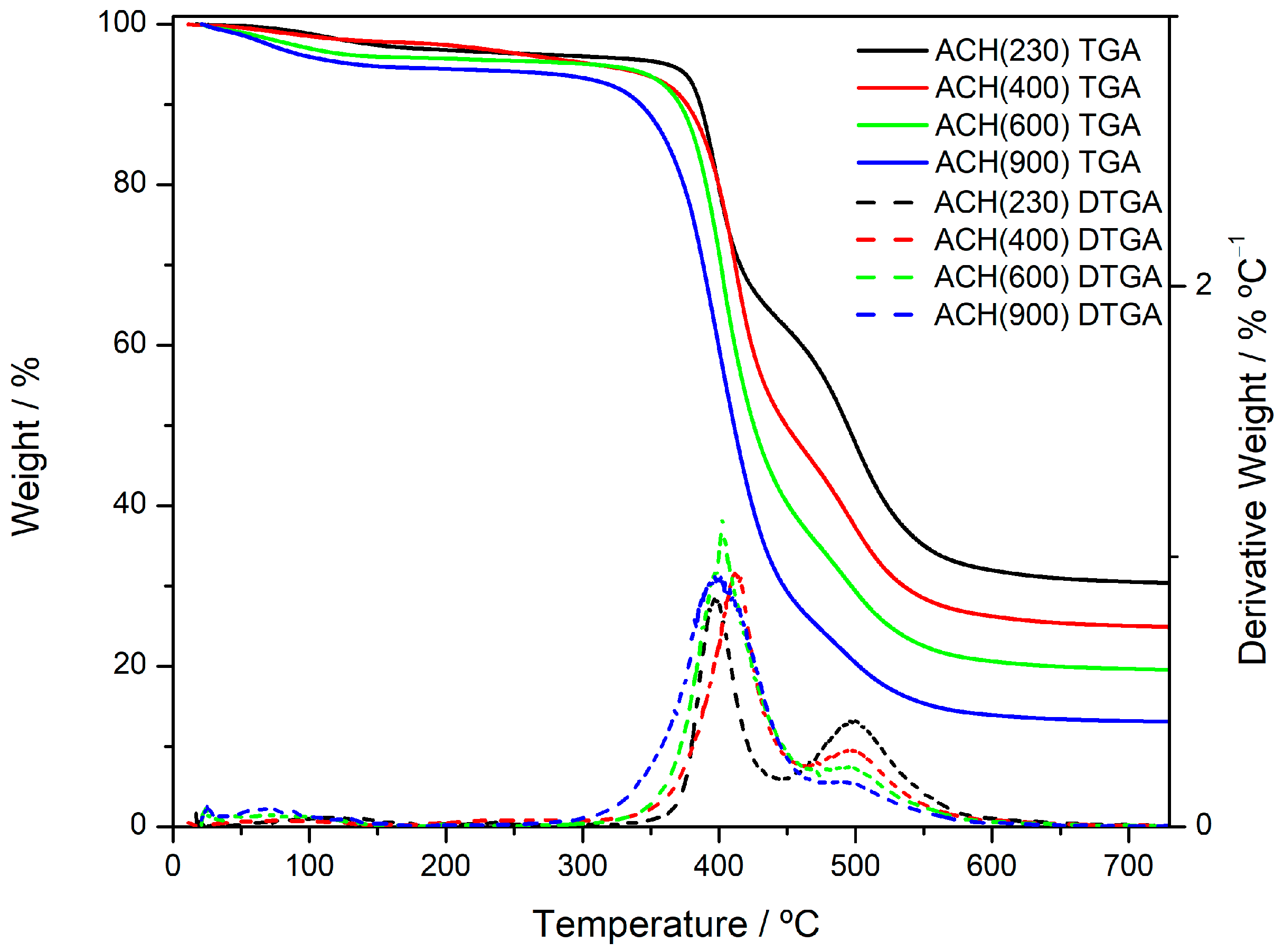Amino-Alcohol Organic-Inorganic Hybrid Sol-Gel Materials Based on an Epoxy Bicyclic Silane: Synthesis and Characterization †
Abstract
:1. Introduction
2. Materials and Methods
2.1. Materials
2.2. Synthesis of OIH Matrices
2.3. Characterization of OIH Matrices
2.3.1. Fourier Transform Infrared Spectroscopy (FTIR)
2.3.2. Nuclear Magnetic Resonance (NMR)
2.3.3. BET
2.3.4. Electrochemical Characterization (EIS)
2.3.5. Thermal Characterization (TGA)
2.3.6. Optical Characterization (UV/Vis Spectroscopy)
3. Results and Discussion
3.1. Synthesis of Organic-Inorganic Hybrid (OIH) Films
3.2. Nuclear Magnetic Resonance (NMR)
3.3. Fourier Transform Infrared Spectroscopy (FTIR)
3.4. BET
3.5. Optical Analysis
3.6. Electrochemical Impedance Spectroscopy (EIS)
3.7. Thermogravimetric Analysis
4. Conclusions
Supplementary Materials
Author Contributions
Funding
Data Availability Statement
Acknowledgments
Conflicts of Interest
References
- Kistler, S.S. Coherent Expanded Aerogels and Jellies. Nature 1931, 127, 741. [Google Scholar] [CrossRef]
- Schmidt, H. New Type of Non-Crystalline Solids between Inorganic and Organic Materials. J. Non-Cryst. Solids 1985, 73, 681–691. [Google Scholar] [CrossRef]
- Hench, L.L.; West, J.K. The Sol-Gel Process. Chem. Rev. 1990, 90, 33–72. [Google Scholar] [CrossRef]
- Brinker, C.J.; Scherer, G.W. Sol-Gel Science: The Physics and Chemistry of Sol-Gel Processing, 1st ed.; Academic Press: Amsterdam, The Netherlands, 2013. [Google Scholar]
- Sakka, S. Birth of the Sol-Gel Method: Early History. J. Sol-Gel Sci. Technol. 2022, 102, 478–481. [Google Scholar] [CrossRef]
- Figueira, R.B.; Sousa, R.P.C.L.; Silva, C.J.R. Multifunctional and Smart Organic–Inorganic Hybrid Sol-Gel Coatings for Corrosion Protection Applications. In Advances in Smart Coatings and Thin Films for Future Industrial and Biomedical Engineering Applications; Elsevier: Amsterdam, The Netherlands, 2020; pp. 57–97. [Google Scholar]
- Pierre, A.C. Applications of Sol-Gel Processing. In Introduction to Sol-Gel Processing; Pierre, A.C., Ed.; The Kluwer International Series in Sol-Gel Processing: Technology and Applications; Springer: Boston, MA, USA, 1998; pp. 347–386. [Google Scholar] [CrossRef]
- Wen, J.; Wilkes, G.L. Organic/Inorganic Hybrid Network Materials by the Sol−gel Approach. Chem. Mater. 1996, 8, 1667–1681. [Google Scholar] [CrossRef]
- Carlos, L.D.; de Zea Bermudez, V.; Sá Ferreira, R.A.; Marques, L.; Assunção, M. Sol−gel Derived Urea Cross-Linked Organically Modified Silicates. 2. Blue-Light Emission. Chem. Mater. 1999, 11, 581–588. [Google Scholar] [CrossRef]
- Figueira, R.B.; Silva, C.J.R. Application of Sol-Gel Method to Synthesize Organic–Inorganic Hybrid Coatings to Minimize Corrosion in Metallic Substrates. In Hybrid Organic-Inorganic Interfaces; John Wiley & Sons, Ltd.: New Jersey, NJ, USA, 2017; pp. 355–412. [Google Scholar] [CrossRef]
- Ikake, H.; Hara, S.; Shimizu, S. Skillful Control of Dispersion and 3D Network Structures: Advances in Functional Organic–Inorganic Nano-Hybrid Materials Prepared Using the Sol-Gel Method. Polymers 2022, 14, 3247. [Google Scholar] [CrossRef]
- Catauro, M.; Vecchio Ciprioti, S. Sol-Gel Synthesis and Characterization of Hybrid Materials for Biomedical Applications. In Thermodynamics and Biophysics of Biomedical Nanosystems: Applications and Practical Considerations; Demetzos, C., Pippa, N., Eds.; Series in BioEngineering; Springer: Singapore, 2019; pp. 445–475. [Google Scholar] [CrossRef]
- Figueira, R.B.; Silva, C.J.; Pereira, E.V.; Salta, M.M. Alcohol-Aminosilicate Hybrid Coatings for Corrosion Protection of Galvanized Steel in Mortar. J. Electrochem. Soc. 2014, 161, C349–C362. [Google Scholar] [CrossRef]
- Sousa, R.P.C.L.; Figueira, R.B.; Gomes, B.R.; Costa, S.P.G.; Azenha, M.; Pereira, R.F.P.; Raposo, M.M.M. Organic-Inorganic Hybrid Sol-Gel Materials Doped with a Fluorescent Triarylimidazole Derivative. RSC Adv. 2021, 11, 24613–24623. [Google Scholar] [CrossRef]
- Gomes, B.R.; Figueira, R.B.; Costa, S.P.G.; Raposo, M.M.M.; Silva, C.J.R. Synthesis, Optical and Electrical Characterization of Amino-Alcohol Based Sol-Gel Hybrid Materials. Polymers 2020, 12, 2671. [Google Scholar] [CrossRef]
- Li, C.; Wilkes, G.L. Silicone/Amine Resin Hybrid Materials as Abrasion Resistant Coatings. Chem. Mater. 2001, 13, 3663–3668. [Google Scholar] [CrossRef]
- Chattopadhyay, D.K.; Raju, K.V.S.N. Structural Engineering of Polyurethane Coatings for High Performance Applications. Prog. Polym. Sci. 2007, 32, 352–418. [Google Scholar] [CrossRef]
- Moon, I.K.; Chun, H. High Transparent Thermal Curable Hybrid Polycarbonate Films Prepared by the Sol-Gel Method. J. Sol-Gel Sci. Technol. 2009, 52, 49–55. [Google Scholar] [CrossRef]
- Matsukawa, K.; Matsuura, Y.; Nakamura, A.; Nishioka, N.; Motokawa, T.; Muraswe, H. Preparation of Organic-Inorganic Hybrids by Cationic Photopolymerization of Fluorene Diglycidyl Ether. J. Photopolym. Sci. Technol. 2006, 19, 89–92. [Google Scholar] [CrossRef]
- Rabinovich, L.; Lev, O. Sol-Gel Derived Composite Ceramic Carbon Biosensors. In Novel Approaches in Biosensors and Rapid Diagnostic Assays; Liron, Z., Bromberg, A., Fisher, M., Eds.; Springer: Boston, MA, USA, 2001; pp. 111–125. [Google Scholar] [CrossRef]
- Serra, A.; Ramis, X.; Fernández-Francos, X. Epoxy Sol-Gel Hybrid Thermosets. Coatings 2016, 6, 8. [Google Scholar] [CrossRef]
- Figueira, R.; Callone, E.; Silva, C.; Pereira, E.; Dirè, S. Hybrid Coatings Enriched with Tetraethoxysilane for Corrosion Mitigation of Hot-Dip Galvanized Steel in Chloride Contaminated Simulated Concrete Pore Solutions. Materials 2017, 10, 306. [Google Scholar] [CrossRef] [PubMed]
- Hakimi, M.; Mardani, Z.; Moeini, K.; Mohr, F.; Fernandes, M.A. Palladium, Cadmium and Mercury Complexes of 2-((2-((2-Hydroxyethyl)Amino)Ethyl)Amino)Cyclohexanol: Synthesis, Structural, Spectral and Solution Studies. Polyhedron 2014, 67, 27–35. [Google Scholar] [CrossRef]
- Borovin, E.; Callone, E.; Ceccato, R.; Quaranta, A.; Dirè, S. Adsorptive Properties of Sol-Gel Derived Hybrid Organic/Inorganic Coatings. Mater. Chem. Phys. 2014, 147, 954–962. [Google Scholar] [CrossRef]
- Coates, J. Interpretation of Infrared Spectra, a Practical Approach. In Encyclopedia of Analytical Chemistry; American Cancer Society: Atlanta, GA, USA, 2006. [Google Scholar] [CrossRef]
- Sousa, R.P.C.L.; Figueira, R.B.; Gomes, B.R.; Sousa, S.; Ferreira, R.C.M.; Costa, S.P.G.; Raposo, M.M.M. Hybrid Sol-Gel Matrices Doped with Colorimetric/Fluorimetric Imidazole Derivatives. Nanomaterials 2021, 11, 3401. [Google Scholar] [CrossRef] [PubMed]
- Vertuccio, L.; Guadagno, L.; D’Angelo, A.; Viola, V.; Raimondo, M.; Catauro, M. Sol-Gel Synthesis of Caffeic Acid Entrapped in Silica/Polyethylene Glycol Based Organic-Inorganic Hybrids: Drug Delivery and Biological Properties. Appl. Sci. 2023, 13, 2164. [Google Scholar] [CrossRef]
- Abou Hammad, A.B.; Mansour, A.M.; Elhelali, T.M.; El Nahrawy, A.M. Sol-Gel/Gel Casting Nanoarchitectonics of Hybrid Fe2O3–ZnO/PS-PEG Nanocomposites and Their Optomagnetic Properties. J. Inorg. Organomet. Polym. 2023, 33, 544–554. [Google Scholar] [CrossRef]
- Arkles, B.; Larson, G. Silicon Compounds: Silanes & Silicones, 3rd ed.; Gelest Inc.: Morrisville, PA, USA, 2013. [Google Scholar]
- Brown, J.F., Jr. The Polycondensation of Phenylsilanetriol. J. Am. Chem. Soc. 1965, 87, 4317–4324. [Google Scholar] [CrossRef]
- Dirè, S.; Borovin, E.; Ribot, F. Architecture of Silsesquioxanes. In Handbook of Sol-Gel Science and Technology; Klein, L., Aparicio, M., Jitianu, A., Eds.; Springer: Cham, Switzerland, 2016; pp. 1–34. [Google Scholar] [CrossRef]
- Park, E.S.; Ro, H.W.; Nguyen, C.V.; Jaffe, R.L.; Yoon, D.Y. Infrared Spectroscopy Study of Microstructures of Poly(Silsesquioxane)s. Chem. Mater. 2008, 20, 1548–1554. [Google Scholar] [CrossRef]
- Krämer, J.; Kang, R.; Grimm, L.M.; De Cola, L.; Picchetti, P.; Biedermann, F. Molecular Probes, Chemosensors, and Nanosensors for Optical Detection of Biorelevant Molecules and Ions in Aqueous Media and Biofluids. Chem. Rev. 2022, 122, 3459–3636. [Google Scholar] [CrossRef] [PubMed]
- Moreira, S.D.F.C.; Silva, C.J.R.; Prado, L.A.S.A.; Costa, M.F.M.; Boev, V.I.; Martín-Sánchez, J.; Gomes, M.J.M. Development of New High Transparent Hybrid Organic-Inorganic Monoliths with Surface Engraved Diffraction Pattern. J. Polym. Sci. Part B Polym. Phys. 2012, 50, 492–499. [Google Scholar] [CrossRef]
- de Zea Bermudez, V.; Carlos, L.D.; Alcácer, L. Sol−gel Derived Urea Cross-Linked Organically Modified Silicates. 1. Room Temperature Mid-Infrared Spectra. Chem. Mater. 1999, 11, 569–580. [Google Scholar] [CrossRef]
- Hirschorn, B.; Orazem, M.E.; Tribollet, B.; Vivier, V.; Frateur, I.; Musiani, M. Determination of Effective Capacitance and Film Thickness from Constant-Phase-Element Parameters. Electrochim. Acta 2010, 55, 6218–6227. [Google Scholar] [CrossRef]
- Jorcin, J.-B.; Orazem, M.E.; Pébère, N.; Tribollet, B. CPE Analysis by Local Electrochemical Impedance Spectroscopy. Electrochim. Acta 2006, 51, 1473–1479. [Google Scholar] [CrossRef]
- Barsoukov, E.; Macdonald, J.R. (Eds.) Impedance Spectroscopy: Theory, Experiment, and Applications, 3rd ed.; Wiley: Hoboken, NJ, USA, 2018. [Google Scholar]
- Brug, G.J.; van den Eeden, A.L.G.; Sluyters-Rehbach, M.; Sluyters, J.H. The Analysis of Electrode Impedances Complicated by the Presence of a Constant Phase Element. J. Electroanal. Chem. Interfacial Electrochem. 1984, 176, 275–295. [Google Scholar] [CrossRef]
- Córdoba-Torres, P.; Mesquita, T.J.; Devos, O.; Tribollet, B.; Roche, V.; Nogueira, R.P. On the Intrinsic Coupling between Constant-Phase Element Parameters α and Q in Electrochemical Impedance Spectroscopy. Electrochim. Acta 2012, 72, 172–178. [Google Scholar] [CrossRef]
- José, N.M.; de Almeida Prado, L.A.S.; Schiavon, M.A.; Redondo, S.U.A.; Yoshida, I.V.P. Partially Pyrolyzed Poly(Dimethylsiloxane)-Based Networks: Thermal Characterization and Evaluation of the Gas Permeability. J. Polym. Sci. Part B Polym. Phys. 2007, 45, 299–309. [Google Scholar] [CrossRef]
- De Prado, L.A.S.A.; Torriani, I.L.; Yoshida, I.V.P. Poly(n-Alkylsilsesquioxane)s: Synthesis, Characterization, and Modification with Poly(Dimethylsiloxane). J. Polym. Sci. Part A Polym. Chem. 2010, 48, 1220–1229. [Google Scholar] [CrossRef]
- Figueira, R.B.; Silva, C.J.R.; Pereira, E.V. Hybrid Sol-Gel Coatings for Corrosion Protection of Galvanized Steel in Simulated Concrete Pore Solution. J. Coat. Technol. Res. 2016, 13, 355–373. [Google Scholar] [CrossRef]
- Krupinski, K.; Wagler, J.; Brendler, E.; Kroke, E. A Non-Hydrolytic Sol-Gel Route to Organic-Inorganic Hybrid Polymers: Linearly Expanded Silica and Silsesquioxanes. Gels 2023, 9, 291. [Google Scholar] [CrossRef]
- Saikia, P.; Allou, N.B.; Borah, A.; Goswamee, R.L. Iso-Conversional Kinetics Study on Thermal Degradation of Ni-Al Layered Double Hydroxide Synthesized by ‘Soft Chemical’ Sol-Gel Method. Mater. Chem. Phys. 2017, 186, 52–60. [Google Scholar] [CrossRef]








| OIH Sample | T2 (%) | T3 (%) | DOC |
|---|---|---|---|
| δ (ppm) | −58.3 | −66.3 | |
| ACH(230) | 15.4 | 84.6 | 94.9 |
| ACH(400) | 15.0 | 85.0 | 95.0 |
| ACH(600) | 14.6 | 85.4 | 95.1 |
| ACH(900) | 12.9 | 87.1 | 95.7 |
| OIH Sample | SBET (m2 g−1) | Vpore (cc g−1) | dpore (nm) |
|---|---|---|---|
| ACH(230) | 6.138 | 0.011 | 3.9 |
| ACH(400) | 4.572 | 0.009 | 3.9 |
| ACH(600) | 6.286 | 0.007 | 3.9 |
| ACH(900) | 3.342 | 0.007 | 4.4 |
| OIH Films | Rsample/Ω cm2 | CPE (Q)/S Ω−1 cm−2 | α | |
|---|---|---|---|---|
| ACH(230) | ||||
| ACH(400) | ||||
| ACH(600) | ||||
| ACH(900) |
| OIH Sample | log R/Ω cm2 | C/pF cm2 | εr | −log σ/S cm−1 |
|---|---|---|---|---|
| ACH(230) | 10.40 ± 0.07 | 5.15 ± 0.06 | 8.74 ± 0.10 | 11.23 ± 0.04 |
| ACH(400) | 7.45 ± 0.03 | 1.31 ± 0.18 | 2.60 ± 0.35 | 8.21 ± 0.06 |
| ACH(600) | 7.52 ± 0.30 | 4.99 ± 0.64 | 6.09 ± 0.79 | 8.48 ± 0.37 |
| ACH(900) | 4.86 ± 0.04 | 2.08 ± 0.81 | 2.85 ± 1.11 | 5.78 ± 0.12 |
| OIH Sample | T5 (°C) | Tmax (°C) | EA (kJ mol−1) | Char Yield (%) |
|---|---|---|---|---|
| ACH(230) | 362 | 397/497 | 419/100 | 30.0 |
| ACH(400) | 308 | 413/501 | 169/43 | 24.6 |
| ACH(600) | 307 | 403/493 | 198/18 | 19.3 |
| ACH(900) | 134 | 397/482 | 125/2 | 12.9 |
Disclaimer/Publisher’s Note: The statements, opinions and data contained in all publications are solely those of the individual author(s) and contributor(s) and not of MDPI and/or the editor(s). MDPI and/or the editor(s) disclaim responsibility for any injury to people or property resulting from any ideas, methods, instructions or products referred to in the content. |
© 2023 by the authors. Licensee MDPI, Basel, Switzerland. This article is an open access article distributed under the terms and conditions of the Creative Commons Attribution (CC BY) license (https://creativecommons.org/licenses/by/4.0/).
Share and Cite
Sousa, R.P.C.L.; Figueira, R.B.; Callone, E.; Dirè, S.; Costa, S.P.G.; Raposo, M.M.M. Amino-Alcohol Organic-Inorganic Hybrid Sol-Gel Materials Based on an Epoxy Bicyclic Silane: Synthesis and Characterization. Nanomaterials 2023, 13, 2429. https://doi.org/10.3390/nano13172429
Sousa RPCL, Figueira RB, Callone E, Dirè S, Costa SPG, Raposo MMM. Amino-Alcohol Organic-Inorganic Hybrid Sol-Gel Materials Based on an Epoxy Bicyclic Silane: Synthesis and Characterization. Nanomaterials. 2023; 13(17):2429. https://doi.org/10.3390/nano13172429
Chicago/Turabian StyleSousa, Rui P. C. L., Rita B. Figueira, Emanuela Callone, Sandra Dirè, Susana P. G. Costa, and Maria Manuela M. Raposo. 2023. "Amino-Alcohol Organic-Inorganic Hybrid Sol-Gel Materials Based on an Epoxy Bicyclic Silane: Synthesis and Characterization" Nanomaterials 13, no. 17: 2429. https://doi.org/10.3390/nano13172429








